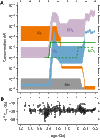Biomass recycling and Earth's early phosphorus cycle
- PMID: 29202032
- PMCID: PMC5706743
- DOI: 10.1126/sciadv.aao4795
Biomass recycling and Earth's early phosphorus cycle
Abstract
Phosphorus sets the pace of marine biological productivity on geological time scales. Recent estimates of Precambrian phosphorus levels suggest a severe deficit of this macronutrient, with the depletion attributed to scavenging by iron minerals. We propose that the size of the marine phosphorus reservoir was instead constrained by muted liberation of phosphorus during the remineralization of biomass. In the modern ocean, most biomass-bound phosphorus gets aerobically recycled; but a dearth of oxidizing power in Earth's early oceans would have limited the stoichiometric capacity for remineralization, particularly during the Archean. The resulting low phosphorus concentrations would have substantially hampered primary productivity, contributing to the delayed rise of atmospheric oxygen.
Figures




References
-
- W. S. Broecker, T.-H. Peng, Z. Beng, Tracers in the Sea (Lamont-Doherty Geological Observatory, Columbia University, 1982).
-
- Tyrrell T., The relative influences of nitrogen and phosphorus on oceanic primary production. Nature 400, 525–531 (1999).
-
- Bjerrum C. J., Canfield D. E., Ocean productivity before about 1.9 Gyr ago limited by phosphorus adsorption onto iron oxides. Nature 417, 159–162 (2002). - PubMed
-
- Planavsky N. J., Rouxel O. J., Bekker A., Lalonde S. V., Konhauser K. O., Reinhard C. T., Lyons T. W., The evolution of the marine phosphate reservoir. Nature 467, 1088–1090 (2010). - PubMed
-
- Jones C., Nomosatryo S., Crowe S. A., Bjerrum C. J., Canfield D. E., Iron oxides, divalent cations, silica, and the early earth phosphorus crisis. Geology 43, 135–138 (2015).
Publication types
MeSH terms
Substances
LinkOut - more resources
Full Text Sources
Other Literature Sources

